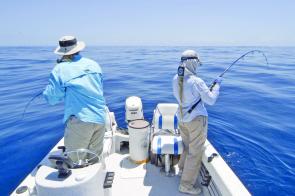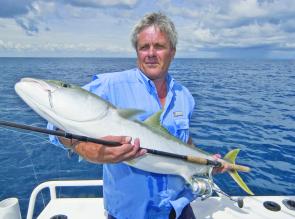Fishing the Southern Bay at this time of year is an exciting prospect with a variety of species on offer. Pelagics, reef fish and estuary species are all active and plenty of good fishing is available everywhere from the deep channels to the shallows.
Deeper parts of the bay produce good numbers of snapper, cod, sweetlip and parrotfish (tuskfish). Pilchard, flesh baits, gar or squid all work well on the first three species and smaller parrotfish will eat prawns or squid. The prime bait for big tuskfish is crab. Chasing big parrotfish is a pursuit for the dedicated with hours spent finding crabs for bait and then patiently waiting for the monster to turn up. When fishing for big parrotfish 36kg (80lb) tackle is considered sporting by some anglers. Most of the coffee rock formations in the Rous and Rainbow channel hold good parrotfish and some of the better-known areas include the Myora and Welsby Lights and the Rous Wall.
The Rous and Rainbow channels have become increasingly popular spots for soft plastics anglers in recent times with good catches of sweetlip, spangled emperor, snapper and cod coming from there. Rather than the usual jig hook rigged lures, treble hooked soft lures such as Jackall Masks and Tranzams are proving the most successful. These lures are well weighted and swim down fast in the deep water and have proved to be quite resistant to snagging on the coffee rock bottom. These lures are armed with trebles which is a major plus when hooking fish down in the depths too. Reef species often fight dirty so sturdy tackle is often necessary to pry them away from their homes. Baitcast outfits spooled with 30lb braid and 30-50lb leaders are quite practical and it doesn’t seem to put the fish off as it would in shallower water.
Prospecting the bay shallows with lures is an often-underrated method of fishing the Southern Bay area. During March the water will still be warm enough for wading and there are a huge variety of species available. Regulars include bream, flathead, whiting, tailor, squid and the odd sweetlip, trevally, snapper, mangrove jack and cod.
All you need is a light spinning outfit spooled with 4-10lb braid and light leader and a handful of lures. With this kind of fishing it’s good to keep on the move: have half a dozen casts over an area then walk, wade, paddle or electric a little further along the bank and cover that area and so on. Boat-based anglers have the advantage of mobility and being able to see into the water. Wading and canoe anglers have a real stealth advantage and can fish right into the skinniest water where big fish will be feeding. Try to fish a rising tide as this is when most fish move up and actively feed in the shallows.
Apart from flathead that lie on the bottom waiting to ambush their prey, most other species will be actively foraging around in the shallow waters, searching for food. If you watch carefully it may be possible to see signs of predators and their prey. Actually spotting fish swimming around can be quite challenging but there are many signs that can give them away. Swirls or fins breaking the surface are the most obvious sign but stirred up mud from fish digging and sifting along the bottom and small flashes as the fish turn to pick things up are the others. Some days seeing prawns and whitebait flickering is a dead giveaway and at other times; egrets stalking the banks can also be a sign of predators pushing bait against the shore. On quiet mornings the sound of a bream noisily slurping off the surface can be heard echoing out of the mangroves for quite a distance. Shallow water stalking may not be the best way to rack up a cricket score of fish but it is still great fishing in areas that most people overlook.
Until next month, tight lines, or for more information on the southern Moreton Bay area, come and see me at Fish Head (Cnr Broadwater Tce and Stradbroke St, Redland Bay, www.fishhead.com.au) or call us on (07) 3206 7999.
Reads: 6039
A nice haul of whiting caught by Tony Kickert.

This grassy sweetlip ate a Tranzam in ayu colour.

A double hook-up on plastics on a glassed out morning.

Barry Goode with a 15kg bay kingfish taken on a G.Loomis Pro Blue rod and Pflueger reel.




